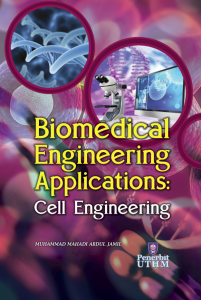BIOMEDICAL ENGINEERING APPLICATIONS: CELL ENGINEERING
Synopsis
This book comprises of four chapters demonstrating the studies which involve cell culture with bioinstrumentation experimental work identifying the potential solutions for wound healing applications via exploitation of high voltage electric field or micro second pulse. The high voltage exposure on cells have shown interesting findings which gives us an idea on how to develop a dug free wound healing method in the nearest future. The book also consists of two chapters that will present about the investigation of bone microstructures acquired from human samples. In this study there will be combination of bone histomorphology, imaging processing and computational method analysis thus also a new biomedical engineering application. Traditionally, the investigation of bone microstructures was performed by forensic officer by looking through microscope and their expert estimation by years of experience. However, by having the engineers joining this investigation we could help the forensic officer to perform the analysis through computational method and automated analysis. Therefore the accomplishment of the six chapters will give an idea for the reader on what to expert in the field of research the so called “Cell Engineering”.
Downloads
References
Alma,Y., Valds-Flores, M., Orozco, L., & Velzquez-Cruz, R. (2013).
‘Molecular Aspects of Bone Remodeling’, Topics In
Osteoporosis.
Balthazard et Lebrun, (1911). les canaux de havers de Io’s humain aux
differents ages. An. Hyg. Publ. et Med, Leg., 114.
Cho, H., Stout, S.D., Madsen, R.W., and Streeter, M.A. (2002).
‘Population-specific histological age-estimating method: a
model for known African-American and European-American
skeletal remains’, Journal of forensic sciences. 47, (1), pp. 12-18.
Ericksen, M.F. (1991). Histologic estimation of age at death using the
anterior cortex of the femur. Am J Phys Anthropol. 84, (2), pp.
-179.
Feng X, M. J. (2011). Disorders of Bone Remodeling, Annu Rev Pathol
(6), 121-145.
Kerley, E.R. (1965). The microscopic determination of age in human
bone’, American Journal of Physical Anthropology, 23, (2), pp.
-163.
Maat, G.J., Maes, A., Aarents, M.J., and Nagelkerke, N.J. (2006).
Histological age prediction from the femur in a contemporary
Dutch sample. The decrease of nonremodeled bone in the
anterior cortex, Journal of forensic sciences, 51(2), pp. 230-237.
Singh, I.J., and Gunberg, D.L. (1970). ‘Estimation of age at death in
human males from quantitative histology of bone fragments’,
Am J Phys Anthropol 33(3), pp. 373-381.
Stout, S.D. (1986). The use of bone histomorphometry in skeletal
identification: the case of Francisco Pizarro. Journal of forensic
sciences, 31(1), pp. 296-300.
Thompson, D.D. (1979). The core technique in the determination of
age at death of skeletons, Journal of forensic sciences, 24(4), pp.
-915.
Thompson, D.D. (1980). Age changes in bone mineralization, cortical
thickness, and haversian canal area, Calcif Tissue Int, 31(1), pp.
Thompson, D.D. (1981). Microscopic determination of age at death in
an autopsy series Journal of Forensic Science, 26(3), pp. 470-
Rutgers Website.
http://www.rci.rutgers.edu/~uzwiak/AnatPhys/APFallLect8.html




